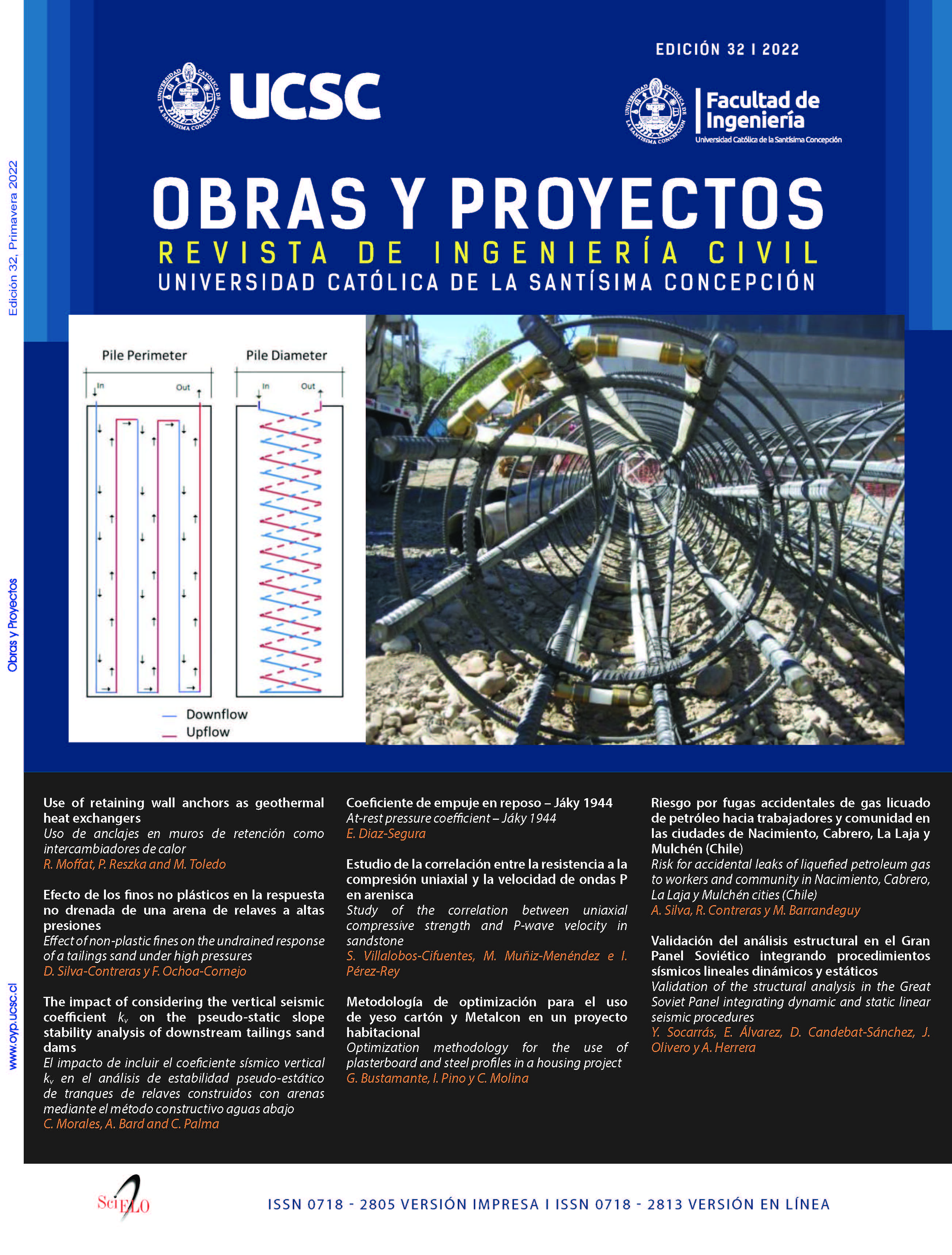The impact of considering the vertical seismic coefficient kv on the pseudostatic slope stability analysis of downstream tailings sand dams
DOI:
https://doi.org/10.21703/0718-51620202203203Keywords:
Pseudo-static analysis, Downstream tailings dams, Vertical seismic coefficientAbstract
In Chile, the limit equilibrium analysis under pseudostatic conditions is compulsory according to the Supreme Decree 248 (DS248, 2007), which establishes a minimum factor of safety (FoS) of 1.2 for stability analysis. In Chilean geotechnical practice, it is usually considered just the horizontal seismic coefficient (kh) for the analyses. However, there is a constant discussion about the necessity of applying both horizontal and vertical seismic coefficient (kv) into the analyses. In addition, there is uncertainty about what kv/kh should be considered and the effect that the sense of application (upward or downward) could have on the FoS. This paper presents an analysis of the effect of considering different |kv|/kh from 0 to 1 on both analysis directions for generic downstream tailings sand dam. Based on this, different dam heights, beach lengths and seepage conditions are also analysed. The obtained results show that when both kh and kv are applied, the FoS increase if kv acts downward and decrease when it acts upward. In addition, the effect for |kv|/kh ≤ 0.5 is almost neglectable, especially for kh ≤ 0.15. Furthermore, although a short beach length significantly impacts the FoS, the influence of applying both kh and kv seems to be independent of the beach length.
References
ANCOLD (2012). Guidelines on tailings dams: planning, design, construction, operation and closure. Australian National Committee on Large Dams ANCOLD, Hobart, Tasmania, Australia.
Barrera, S., Valenzuela, L. and Campaña, J. (2011). Sand tailings dams: design, construction and operation. Tailings and Mine Waste Conference, University of British Columbia, Norman B. Keevil Institute of Mining Engineering, Vancouver BC, Canada.
Blight, G.E. (2010). Geotechnical engineering for mine waste storage facilities. Taylor & Francis, London UK.
Bray, J.D. and Travasarau, T. (2011). Pseudostatic slope stability procedure. 5th International Conference on Earthquake Geotechnical Engineering, SOCHIGE, Santiago, Chile, R. Verdugo (ed.), 255-266.
Bray, J.D., Macedo, J. and Travasarou, T. (2018). Simplified procedure for estimating seismic slope displacements for subduction zone earthquakes. Journal of Geotechnical and Geoenvironmental Engineering 144(3), 04017124.
Campaña, J. (2019). Reflexiones sobre el coeficiente sísmico para análisis seudoestáticos en el diseño de presas. Charla técnica, ICOLD, Santiago, Chile.
DS248 (2007). Reglamento para la aprobación de proyectos de diseño, construcción, operación y cierre de los depósitos de relave. Decreto Supremo, Ministerio de Minería, Servicio Nacional de Geología y Minería SERNAGEOMIN, Santiago, Chile.
DS86 (1970). Reglamento de construcción y operación de tranques de relave. Decreto Supremo, Ministerio de Minería, Santiago, Chile.
ICOLD (2001). Tailings dams - risk of dangerous occurrences, lessons learnt from practical experiences. Bulletin 121. United Nations Environmental Programme UNEP, Division of Technology, Industry and Economics DTIE and International Commission on Large Dams ICOLD, Paris, France.
Kramer, S.L. (1996). Geotechnical earthquake engineering. Prentice-Hall, New Jersey, USA.
Melo, C. and Sharma, S.B. (2004). Seismic coefficients for pseudostatic slope analysis. 13th World Conference on Earthquake Engineering, Vancouver BC, Canada, paper 369.
Morgenstern, N.R. and Price V.E. (1965). The analysis of the stability of general slip surfaces. Géotechnique 15(1), 79-93.
Morgenstern, N.R., Vick, S.G., Viotti, C.B. and Watts, B.D. (2016). Fundão tailings dam review panel: Report on the immediate causes of the failure of the Fundão dam. Cleary Gottlieb Steen & Hamilton, LLP, New York NY, USA.
Morgenstern, N.R., Vick, S.G. and van Zyl, D. (2015). Independent expert engineering investigation and review panel: Report on Mount Polley tailings storage facility breach. Government of the Province of British Columbia, Victoria BC, Canada.
Noda, S. and Uwabe, T. (1976). Relation between seismic coefficient and ground acceleration for gravity quay wall. 6thWorld Conference on Earthquake Engineering, New Delhi, India, vol. 2, 1963-1968.
Ramírez, N. (2010). Effects of the 2010 earthquake on tailings disposals located on the South-Central Chile and its relation with Decreto 248. Seminar: Proposals for the Operation of Tailings Disposals According to Recent Experiences. Santiago, Chile.
Rico, M., Benito, G., Salgueiro, A.R., Díez-Herrero, A. and Pereira, H.G. (2008). Reported tailings dam failures: a review of the European incidents in the worldwide context. Journal of Hazardous Materials 152(2), 846-852.
Robertson, P.K., de Melo, L., Williams, D.J. and Wilson, G.W. (2019). Report of the expert panel on the technical causes of the Failure of Feijão Dam I. Skadden, Arps, Slate, Meagher & Flom LLP, New York NY, USA.
Sahoo, P.P. and Shukla, S.K. (2021). Effect of vertical seismic coefficient on cohesive-frictional soil slope under generalised seismic conditions. International Journal of Geotechnical Engineering 15(1), 107-119.
Sahoo, P.P., Shukla, S.K. and Mohyeddin, A. (2018). Analytical expressions for determining the stability of cohesionless soil slope under generalised seismic conditions. Journal of Mountain Science 15(7), 1559-1571.
Saragoni, R. (1993). Análisis del riesgo sísmico para la reconstrucción del Puerto de Valparaíso. 6tas Jornadas Chilenas de Sismología e Ingeniería Antisísmica, Universidad de Chile y ACHISINA, Santiago, Chile, vol. II, 165-178.
Sarma, S.K. (1975). Seismic stability of earth dams and embankments. Géotechnique 25(4), 743–761.
Sarsby, R.W. (2013). Tailings dams. Chapter 15: Environmental Geotechnics, R.W. Sarsby (ed.), ICE Publishing, London,UK, 2nd edition, 365-391.
Shukha, R. and Baker, R. (2008). Design implications of the vertical pseudo-static coefficient in slope analysis. Computers and Geotechnics 35(1), 86–96.
Slide2 (2018). 2D slope stability analysis program using limit equilibrium method. Version 7.0, Rocscience Inc., Toronto, Canada.
Towhata, I. (2008). Geotechnical earthquake engineering. Springer-Verlag, Berlin, Germany.
Troncoso, J. (2002). Dynamic properties and seismic behavior of thickened tailings deposits. International Symposium on Paste and Thickened Tailings Disposal, Pontificia Universidad Católica de Chile, Santiago, Chile.
Troncoso, J.H. (1996). Geotechnics of tailings dams and sediments. 2nd International Congress on Environmental Geotechnics 2ICEG, Osaka, Japan, M. Kamon (ed.), Balkema, the Netherlands, vol. 3, 1405–1423.
Valenzuela, L. (2016). Design, construction, operation and the effect of fines content and permeability on the seismic performance of tailings sand dams in Chile. Obras y Proyectos 19, 6-22.
Valenzuela, L. (2015). Tailings dams and hydraulic fills. The 2015 Casagrande Lecture. 15th Pan-American Conference on Soil Mechanics and Geotechnical Engineering and 8th South American Congress on Rock Mechanics, Buenos Aires, Argentina, A.O. Sfriso, D. Manzanal and R.J. Rocca (eds.), IOP Press, Amsterdam, the Netherlands, vol. 5, 5-49.
Vick, S.G. (1983). Planning, design and analysis of tailings dams. John Wiley & Sons, New York, USA.
Villavicencio, G., Espinace, R., Palma, J., Fourie, A. and Valenzuela, P. (2014). Failures of sand tailings dams in a highly seismic country. Canadian Geotechnical Journal 51(4), 449-464.
Downloads
Published
Issue
Section
License
Copyright (c) 2022 Universidad Católica de la Santísima Concepción

This work is licensed under a Creative Commons Attribution-NonCommercial 4.0 International License.








